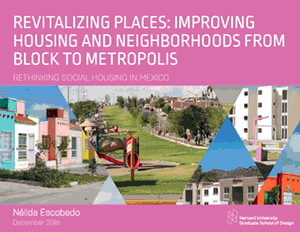In 2012, the Mexican government introduced a wide range of reforms designed to increase the country’s competitiveness and economic growth potential, including development of a new approach to housing and urban policy. A new federal ministry, the Secretariat of Urban, Agrarian, and Territorial Development (SEDATU), was created to coordinate and carry out those urban, regional, and housing reforms with the objective of consolidating housing near existing urban areas and providing high-quality housing to more Mexicans, including those from lower-income groups.
In an effort to more efficiently accomplish these goals, research was commissioned in 2013 by the National Workers’ Housing Fund Institute (Instituto del Fondo Nacional de la Vivienda para los Trabajadores, or INFONAVIT), a nongovernmental pension fund that is the world’s third-largest mortgage provider. The institute commissioned the Harvard Graduate School of Design (GSD) to conduct an ongoing research project, Rethinking Social Housing in Mexico (RESHIM), to explore and document challenges related to the production of affordable housing in Mexico.
The findings were presented at Harvard University in December in the report Revitalizing Places: Improving Housing and Neighborhoods from Block to Metropolis, which examines how urban planning and design interventions can help improve housing and urban development practice in Mexico.
“One of the things that this research project allowed us to do was to bring together architects—both student and professional—with urban planning professionals focusing on policy and best practices, as well as persons like myself who are interested in governance and institution building, and we were able to marry these three separate elements together in a final report,” said Diane Davis, one of the report’s principal investigators and chair of the GSD Department of Urban Planning and Design.
The project sought to answer four key questions:
- How have the new national housing and urban policies changed the context in which state and local government actions are critical to the success of the national policies?
- What strategies can be applied to better coordinate different levels of government in order to produce or renovate social housing in urban Mexico?
- What kinds of regulatory and technical tools, or other urban planning and design interventions, will improve current practice and lead to a more financially robust housing policy?
- What levels of government are key to these outcomes, and how can they be mobilized to work together to produce social housing that fits the needs of consumers and producers?
During a panel discussion following presentation of the report, Carlos Zedillo, head of the Research Center for Sustainable Development for INFONAVIT, provided context for the current housing situation in Mexico, attributing some problems to the country’s decision in 1995 to privatize a number of government functions, including housing development. As a result, there is no state-sponsored affordable housing; production is in the hands of private developers who, according to the GSD research, are doing a poor job of delivering adequate housing for working people.
According to Zedillo, citing the GSD research, 60 percent of homeowners who received financing from INFONAVIT did not receive their house on the date that were supposed to move in; 36 percent of all homeowners were unable to occupy their home until at least one year after mortgage payments began. Forty-eight percent said they will never acquire a house from the same developer again, and 57 percent said they would never recommend their developer to a friend or family member. “That is horrible,” said Zedillo.
In addition, over 40 percent of homeowners were unhappy with the location of the houses, which often were built where developers could buy land cheaply.
“A lot of these workers have to travel three hours on average from their houses to work, and they spend, on average, half of their salaries on transportation,” said Zedillo. “If you add up these expenses, it averages 750 pesos [US$36.70] monthly, and one of our mortgages is about 1,500 pesos monthly. So that’s a problem.” It is one that leads many homeowners to abandon their homes. A 2015 report by the Organization for Economic Co-operation and Development (OECD) states that Mexico has “a significant share of vacant housing, with one-seventh of the housing stock uninhabited in 2010.”
The 319-page GSD report was developed by focusing on seven politically and economically diverse metropolitan areas across Mexico—Aguascalientes, Cancún, Guadalajara, Mérida, Monterrey, Oaxaca, and Tijuana—each facing its own challenges regarding densification and social housing development. It identifies four key strategies for creating communities that are more sustainable and inclusive:
- Densify existing areas. The report suggests that this can be achieved by simplifying infill development, promoting public acceptance of infill development, and promoting alternative housing tenures such as accessory apartments.
- Increase development of greenfield sites. Strategies include creating additions to urban areas that are rich in infrastructure and services and incorporating innovative designs to comprehensively develop neighborhoods and new towns.
- Retrofit existing areas. Areas where services and infrastructure are lacking need to be upgraded, and the abandoned housing issue must be addressed. Strategies for doing this include financing upgrades to services and infrastructure, building mixed-use, multifunctional neighborhoods and town centers, and providing better links to jobs.
- Improve data coordination and develop indicators of success. Data and information sharing is a key challenge to promote positive changes in metropolitan areas. It is important to develop measures or indicators of success to understand the effects of policies, programs, and strategies and to provide feedback.
INFONAVIT has embraced the research and begun implementing some of the recommendations, Zedillo said. “It was crazy to think that for the [world’s third-largest] mortgage institution, that we did not have a research-oriented area, but research has become a critical part of this institution,” he added.





